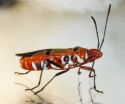Chemical modules that mimic predator-prey and other behaviors
2013-01-09
(Press-News.org) Scientists are reporting development of chemical modules that can reproduce, on an "unprecedented" molecular level, changes and interactions that occur in natural populations of plants and animals, including those of hunting and being hunted for food, conducting mutually beneficial relationships and competing for resources. The report on these new "predator-prey biochemical oscillators," which could become building blocks for molecular machines and computers, appears in ACS Nano.
Yannick Rondelez and Teruo Fujii explain that just as plants and animals interact in complex ways in vast "ecosystems" in nature, molecules, such as small synthetic DNA fragments, can be made to interact in complex ways within test tubes. Therefore, animal behaviors, like hunting (as a predator) and being hunted (as prey), could also be applied to molecules, they say. Currently, researchers can build simple circuits with molecules. But to make complex molecular machines and computers (which would provide information-processing ability to wet systems), they need to understand and control how groups of molecules interact with each other, as animals do in nature.
The scientists describe reproducing predator-prey interactions, mutually beneficial relationships and competitive conditions using DNA and enzymes that build up or break down DNA. "Therefore, beside opening the way to the study of fundamental issues of chemical dynamic systems, we also expect that this approach will provide a useful building block in the scaling-up of molecular computers and machines," they say.
###
The American Chemical Society is a nonprofit organization chartered by the U.S. Congress. With more than 164,000 members, ACS is the world’s largest scientific society and a global leader in providing access to chemistry-related research through its multiple databases, peer-reviewed journals and scientific conferences. Its main offices are in Washington, D.C., and Columbus, Ohio.
To automatically receive news releases from the American Chemical Society, contact newsroom@acs.org.
The authors acknowledge funding from CNRS and MEXT, Japan.
Twitter Facebook END
ELSE PRESS RELEASES FROM THIS DATE:
2013-01-09
This press release is available in German.
Aggregations of the red and black colored firebugs are ubiquitous under linden trees in Central Europe, where the bugs can reach astounding population densities. While these insects have no impact on humans, their African, Asian, and American relatives, the cotton stainers, are serious agricultural pests of cotton and other Malvaceous plants. Researchers at the Max Planck Institute for Chemical Ecology in Jena, Germany, recently discovered that these bugs need bacterial symbionts to survive on cotton seeds as their sole food source. ...
2013-01-09
To plant food, insect repellant and other homespun uses for spent coffee grounds, scientists are adding an application that could make the gunk left over from brewing coffee a valuable resource for production of dietary supplements. Their new report in ACS' Journal of Agricultural and Food Chemistry concludes that used coffee grounds are a rich source of healthful antioxidant substances.
Maria-Paz de Peña and colleagues explain that people around the world drink millions of cups of coffee every day, generating about 20 million tons of used grounds annually. Although some ...
2013-01-09
URBANA – What are you doing to keep your relationship alive? A University of Illinois study highlights the importance of five relationship maintenance strategies that couples can use to preserve or improve the quality of an intimate relationship.
"Relationships are like cars in that you have do certain things to keep them running, especially when your goal is to strengthen and preserve your bond with your partner," said Brian Ogolsky, a U of I professor of human and community development.
To determine which factors are the most important in promoting healthy relationships, ...
2013-01-09
This press release is available in German.
Whether a quantum object behaves like a wave or like a particle depends (according to the Copenhagen interpretation) on the choice of measurement apparatus used for observing the system, and therefore on the type of measurement performed.
Anton Zeilinger's team of physicists at the University of Vienna and the Austrian Academy of Sciences has recently taken this phenomenon further than ever. Whether a certain photon behaves like a particle or like a wave depends on the measurement performed on a second photon. In the ...
2013-01-09
Mention magnets, and most people think of trivial applications of those pieces of metal, like holding family photos and reminder notes on the refrigerator. An article on magnets in the current edition of Chemical & Engineering News (C&EN), however, focuses on the critical role magnets play in the real world and the search for new materials to make them. C&EN is the weekly newsmagazine of the American Chemical Society, the world's largest scientific society.
In the article, C&EN Senior Correspondent Mitch Jacoby explains that magnets are crucial to an enormous number of ...
2013-01-09
New Rochelle, NY, January 9, 2013—More than 85,000 synthetic chemicals are registered for commercial use with the U.S. Environmental Protection Agency (EPA), and only about half of those produced in large quantities are tested for their potential toxic effects on humans. Children are particularly vulnerable to environmental toxins and a detailed look at how and why, and what can be done to protect children's health, is presented in a two-part article published in Alternative and Complementary Therapies from Mary Ann Liebert, Inc., publishers. The articles are available ...
2013-01-09
Tree seeds, rather than biomass or fuel crop plants, could represent an abundant source of renewable energy, according to research published in the International Journal of Automotive Technology and Management. The study suggests that seeds from the Indian mahua and sal trees have almost as good a thermal efficiency as biodiesel but would produce lower emissions of carbon monoxide, waste hydrocarbons and NOx (nitrogen oxides).
Sukumar Puhan of the GKM College of Engineering and Technology and colleagues N. Vedaraman and K.C. Velappan of the Central Leather Research Institute, ...
2013-01-09
PITTSBURGH—Self-moving gels can give synthetic materials the ability to "act alive" and mimic primitive biological communication, University of Pittsburgh researchers have found.
In a paper published in the Jan. 8 print edition of the Proceedings of the National Academy of Sciences, the Pitt research team demonstrates that a synthetic system can reconfigure itself through a combination of chemical communication and interaction with light.
Anna Balazs, principal investigator of the study and Distinguished Professor of Chemical and Petroleum Engineering in Pitt's Swanson ...
2013-01-09
WINSTON-SALEM, N.C. – Jan. 9, 2013 – New research from Wake Forest Baptist Medical Center shows that patients suffering from aggressive brain tumors can be effectively treated with smaller radiation fields to spare the rest of the brain and preserve cognition.
"For patients with glioblastoma, we now know we can safely and effectively treat them with smaller radiation fields to spare the rest of their normal brain," said lead investigator Michael D. Chan, M.D., assistant professor of radiation oncology at Wake Forest Baptist. "That's important because it lessens the symptoms ...
2013-01-09
Alexandria, Va.–January 9, 2013– America Speaks, Volume 13, a compilation of public opinion polls commissioned by Research!America, features timely data about Americans' views on issues related to biomedical and health research. A majority of Americans (72%) say the new Congress and the President should take action to expand medical research within the first 100 days of the 113th Congress. Public support for increased government spending on medical research holds particular relevance as Congress considers whether to further delay, eliminate or permit "sequestration," a ...
LAST 30 PRESS RELEASES:
[Press-News.org] Chemical modules that mimic predator-prey and other behaviors


